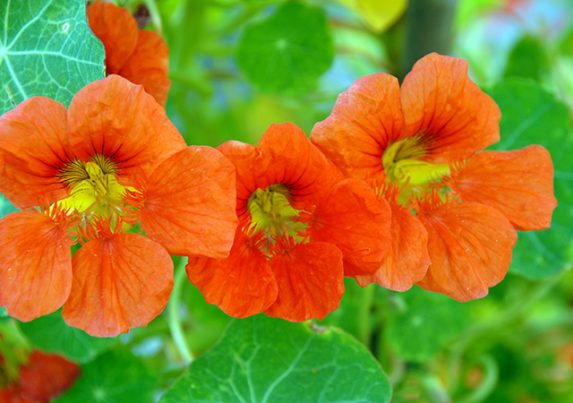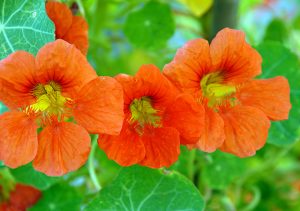
Nasturtium – sources, health benefits, nutrients, uses and constituents at NaturalPedia.com
Tuesday, August 15, 2017 by Earl Garcia
http://www.naturalpedia.com/nasturtium-sources-health-benefits-nutrients-uses-and-constituents-at-naturalpedia-com.html

Nasturtium is an edible flower that is native to South America, especially in Ecuador, Bolivia, Peru, and Colombia. The decorative flowers were used as a topical wound treatment to prevent the onset of infections. According to the Herbal Supplement Resource website, nasturtiums were brought to Europe during the 16th century. The ornamental plant comes in many names such as common nasturtium, climbing nasturtium, garden nasturtium, and Indian cress.
List of known nutrients
Just like other medicinal flowers, nasturtium is loaded with powerful compounds that boost the body’s defenses against a host of diseases. Separate entries posted on the Botanical Online and Herbpathy websites enumerate the important components found in nasturtium. These compounds include:
- Amino Acids
- Anthocyanins
- Carotenoids
- Flavonoids
- Glucosinolates
- Glucotropaeolin
- Iron
- Isoquercitrin
- Manganese
- Mustard Oil
- Oxalic Acid
- Phenolic Compounds
- Spilanthol
- Sulfur
- Vitamin C
- Volatile Oil
Medicinal uses for nasturtium
Nasturtiums are best known for their abundant vitamin C supply, which in turn fortifies the body’s immunity against common cold and influenza. Likewise, the edible flower is known to fend off various fungal infections. The plant also contains strong antibacterial properties that help keep disease-causing bacteria at bay. Aside from this, nasturtium is an excellent source of anthocyanins that contain antioxidant, anti-inflammatory, and antimicrobial properties. The high antioxidant levels found in nasturtium help counter the negative effects of free radicals. Additionally, the phenolic compounds in nasturtium are touted to prevent the onset of chronic disorders such as cancer and heart disease.
Nasturtiums are also touted for their expectorant properties that clear out excessive mucus from the respiratory tract. The edible flowers are also notably effective in addressing various respiratory conditions such as asthma, bronchitis, inflammatory diseases, and cough as well as cold, flu, and emphysema. Aside from this, the ornamental flowers are found to improve the body’s digestive profile. Nasturtiums are shown to boost liver function and performance as well as improve the organ’s bile secretion. The plant’s antibiotic properties also help relieve sore throat. Likewise, the edible flower is shown to lower the risk of developing diabetes.
In addition, nasturtiums are found to address various kidney and urinary tract diseases. According to the Dr. Health Benefits website, nasturtiums are remarkable effective in treating inflammatory conditions, urinary tract infection, and urinary incontinence. On the other hand, the edible flower is traditionally used to relieve muscle pain and boost both physical and mental health. Moreover, the superfood is known to regulate menstrual cycles in women and improve sex drive in men.
Furthermore, nasturtiums are found to address various skin disorders such as impurities, rashes, and injuries as well as relieve hair and scalp diseases. Nasturtiums are also known to alleviate eye diseases.
Body systems supported by nasturtium
Nasturtiums are particularly beneficial in boosting the immune system. Likewise, the superfood is packed with powerful compounds that protect the cardiovascular, respiratory, muscular and digestive systems. The edible flowers also support the ocular, urinary and both male and female reproductive systems.
Ways to use nasturtium
Essential oils extracted from nasturtium can be used to address common colds, while tinctures made from the flower are effective in combating hair loss. Likewise, the flowers can be added to bath water to treat various skin disorders. The edible flower can also be made into a powerful tea to relieve skin and eye conditions. On the other hand, nasturtium leaves are an excellent salad green while the small buds can be pickled. The leaves and stems also make for an ideal pesto alternative. An entry on the Martha Stewart website features an interesting pesto recipe for nasturtium.
Where to learn more
- Do your part and save the bees with these 10 easy-to-grow flowers
- Repel mosquitos naturally with these 10 powerful plants
- 11 Edible Weeds Having Various Medicinal And Healing Properties
- Include these companion plants in your garden to help grow tomatoes
- Use herbs to kill the bacteria that cause urinary tract infections
Summary
Nasturtiums prevent cancer, cardiovascular diseases and bacterial infections.
Nasturtiums stave off respiratory conditions, urinary diseases and muscle pain.
Nasturtiums keep digestive issues, reproductive conditions and diabetes.
Nasturtiums benefits the immune, cardiovascular, muscular and digestive systems.
Nasturtiums support the ocular, respiratory and both the male and female reproductive systems.
Sources include:
Tagged Under: Tags: nasturtium






